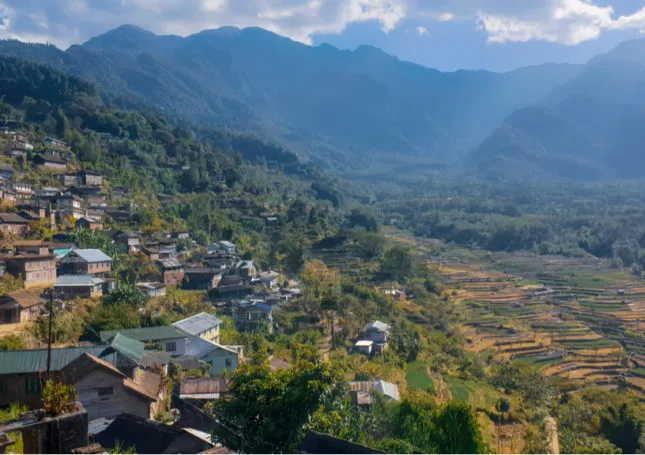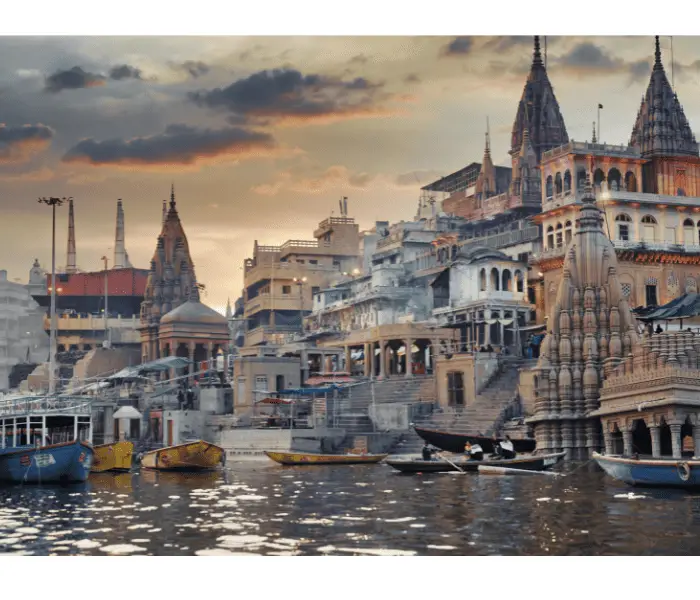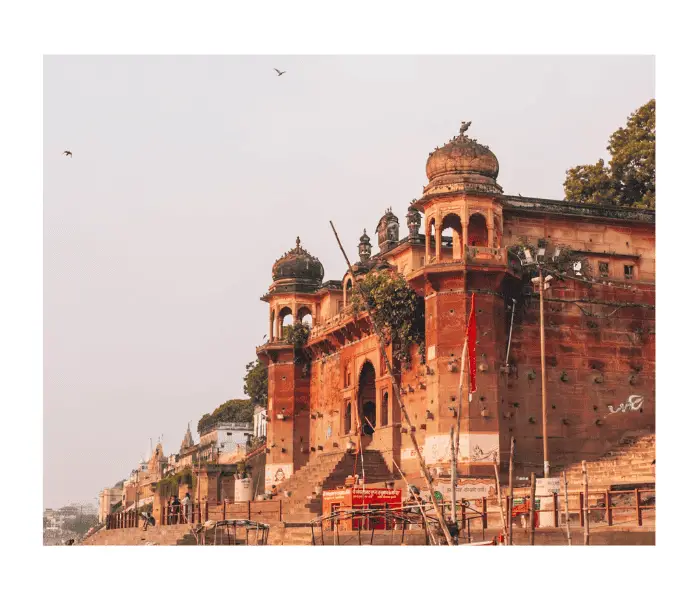India is a vast country. It has an area of 32,872.63 square meters which equates to roughly 2.4% of the earth’s surface. And, like almost every country in the world, it is made up of urban, suburban and rural settlements.
But how many villages are there in India? With a land surface of that size you can imagine there are quite a few villages in India but would you be surprised to learn there are approximately 64,0930 villages in total?
Yes, it’s a staggering amount but there is a saying that ‘the soul of India is in its villages’. And given that 60% of the population still live in villages, it’s easy to understand how the saying is still appropriate in modern times.
Indian villages, like anywhere, range in size from larger populations to tiny villages of less than 500 people.
And they range in style and features depending on factors, such as geographic location and socio-economic elements.
Some Indian villages are renowned for their beauty and are certainly worth a visit while touring the country.
But let’s dive into some of the details about India and its thousands of villages.

Which is the Largest Village in India?
The largest village in India is called Gahmar. At last count, the population of Gahmar was 25,000 which makes it roughly comparable to some small countries elsewhere in the world.
Claiming you are the largest or smallest village anywhere can be controversial. And yet Gahmar claims to be the largest village in the world. Quite the claim!
And coming in at 12 kilometres squared it is pretty big in land area too. Gahmar can be found in the Ghazipur district of Uttar Pradesh and it’s very near the Ganges river.
It’s other claim to fame is that it is known colloquially as the ‘soldiers’ village’ because, on average, one person in every household is either a member of or connected to the Indian armed forces.
From Village to Town for Two Years
Interestingly, the village was upgraded to a town in 1987 because of its size. But only two years later, its town status was revoked after Gahmar’s residents fought against their town designation.
Why? It wasn’t because they had particularly strong opinions towards being called a town per se. They just didn’t want to pay the heavier taxes that came with the new title.
And that’s perhaps a decision we can all understand.
Female First
Another notable fact about the village is that it is quite matriarchal. Many of the civic representatives of the village are women.
And, most of the households are headed by women. It is actually the women who encourage their sons and grandsons to join the country’s armed forces.
Now that the first batch of female cadets have been accepted for basic training in the Indian Army and NDA, it will be interesting if the female heads of the household will also encourage their daughters to join up and create a new tradition of female warriors for the village.
What State Has the Most Villages in India?
Not only is Gahmar the biggest village in India, but the state it’s in also lays claim to being the state with the most villages.
According to the 2011 census, there are 100,000 villages in the state of Uttar Pradesh alone.
You’d be forgiven for assuming that Uttar Pradesh must be the largest state by area in the country. In fact, it’s only the fourth biggest state, after Rajasthan, Madhya Pradesh and Maharashtra.
But it’s still pretty big – it’s the same size as the UK! It’s so big that it has two capital cities – Lucknow is the state capital, while Allahabad serves as the judicial capital.
An Uttar Delight
Uttar Pradesh is to the North East of the country and shares a border with Nepal. It’s known for its religious heritage, traditional architecture and rich culture with an interesting mix of Hindi, Bhojpuri and Urdu literature, music and art.
Because of its heritage, including the awe-inspiring Taj Mahal, it attracts many national and international tourists.
The state has made constructive efforts to retain its cultural and ethnic authenticity and to preserve its customs and traditions. Perhaps this is why it is such a draw for tourists to the country.
The cities of Lucknow and Varanasi are a mix of traditional and modern, like most historic cities. And, as you would expect, are fast-paced and comparatively expensive to visit or live in.
As you move out of the main cities and into the villages, you can expect to enjoy a more modest expenditure for your daily needs.

Which Villages Are The Most Popular for Tourist in Uttar Pradesh?
The Taj Mahal is not the only draw to the state of Uttar Pradesh. It is full of beautiful villages which capture the tranquillity and spirituality you might expect from an area so closely connected to its religious and cultural practices.
Bateshwar, in the district of Agra, is worth a notable mention. It is in the same region as the Taj Mahal. But despite its proximity to this world-famous cultural site, Bateshwar holds its own significance.
For Hindus and Jains, Bateshwar has an important spiritual draw. The village celebrates a yearly religious fair that honours Lord Shiva.
The fair centres around the Bateshwar Nath Temple although there are more than a hundred temples devoted to Shiva in the vicinity.
Kathwara, near Lucknow, is another village that has strong spiritual significance for Hindus. It is quite a large village with a population of over 6,000.
But this is perhaps because of its ancient beginnings and continued occupation.
The village traces its origins back to myth and is linked to the third age in the Yuga Cycle, known as the Dvapara Yuga to Hindus.
The Chandrika Devi Temple is located in Kathwara, dedicated to the Hindu mother goddess Durga.
Because of Kathwara’s cultural and spiritual significance, it’s a popular site of pilgrimage for those living across the state or from the country as a whole.
It’s also popular with international tourists who want to understand the faith and cultural practices of Hindus as well as experience the beauties of the village’s countryside location. Its proximity to the state capital, Lucknow, facilitates its popularity too.
Shringverpur is a village that’s easily accessible from the judicial capital of Allahabad. And it is another site that is grounded in the Hindu tradition. This village has ancient origins as the place where three Hindu legendary figures crossed the sacred river and went into exile.
The ancient Shringi Rishi temple in the village was rediscovered and is thought to be the likeliest origin of the village’s name. Proving that is and may have always been a village with special spiritual significance.
And its site, on the sacred river Ganges, gives Shringverpur a continued link to its religious past and present.
The village of Kotwan in Uttar Pradesh’s district of Mathura is one of the most significant spiritual locations in the region. It’s where Hindus believe the deity Krishna spent his early life.
It is for this reason that certain Hindu denominations regard Kotwan as a sacred site.
And is also considered a place of pilgrimage for followers of Krishna. Not only this but the village’s link to Uttar Pradesh’s culture and India’s historic past in general makes it a popular site for tourists too.

How Big Is a Village In India?
It seems that the term village is as elastic in India as it is in Britain. And like us, there is no clear definition of what constitutes a village.
There seems a cultural agreement that villages need to have a green buffer zone and that the population is significantly less than those of towns.
The only definition for the parameters of a village in India are those suggested by the UN Statistical Commission. But we think that almost any village dwellers the world over would resist any imposition or restriction of the term ‘village’ from an outside agency.
As we have seen, India’s largest village, Gahmar, has a population of 25,000, according to the 2011 census.
And while that seems like a few too many inhabitants to really be classified as a village, who are we to argue?
Generally though, most villages in India range in population size from between 2,000 to 10,000. And because population size usually determines the area that a village occupies on the map, this seems as good an indication of the definition “big” as any.
The one thing about villages in India, as in any country, is they tend to retain the history and culture of the region or country in which they are sited to a far greater degree than their more urban counterparts.
They capture the essence of what is best about a country and preserve it like a jewel. It’s a jewel generally wrapped in the beauties of the countryside which may be agricultural, mountainous or river-side.
And, it is because of these reasons that India’s villages are not only worth visiting if you are a tourist but are a source of pride and veneration for those who reside anywhere in India.


